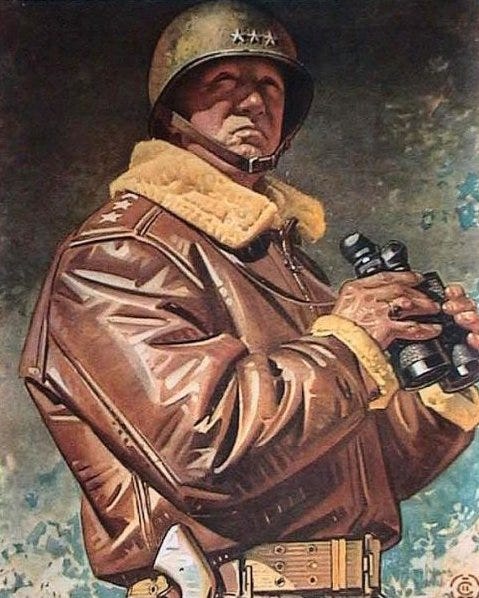https://medium.com/moxietalk-with-kirt-jacobs/p-a-t-t-o-n-blood-guts-moxie-5b2636fde3b5
It would have been fitting if George S. Patton had gone out in a blaze of glory, leading an attack on an enemy. However, one of the most valiant Generals, arguably, the United States ever produced, died a most ignominious death!
Instead, he died 75 years ago today after being gravely hurt in a relatively minor auto accident that caused only minor injuries to the vehicle’s other occupants. He was just 60 years old when his spirit slipped away from his paralyzed body as it lay in a hospital bed in Germany. His remains were put to rest among his men at the Luxembourg American Cemetery and Memorial.
America reveres its great military leaders — Washington, Grant, MacArthur, Pershing — and Patton’s name certainly has a place in that constellation. It takes moxie to join the ranks of America’s most valorous heroes, and Patton had it.
Here’s how:
Moxie knows where it comes from and where it’s going.
Patton’s interest in all things military began early and never faltered. He was born in California in 1885, the scion of the district attorney for Los Angeles. He could trace his aristocratic roots back to Edward I of England, and his ancestors included lords and barons and war heroes who fought in the American Revolution and the Civil War. He was exceptionally proud of his heritage, and believed in reincarnation, too. He carried all of his ancestors with him into battle, and also the spirits of the soldiers and leaders he believed he’d been in past lives.
Reading did not come easy to him, but as soon as he was able to master the art he dove into classical military history books. His passion carried him to his father’s Alma Mater, Virginia Military Institute, and on to an appointment at West Point and a commission in the U.S. Army’s Calvary.
For the rest of his career, Patton sought to be where the action was. He chased war around the globe from defending the southern border against Pancho Villa to World War I to World War II.
Patton drove forward with a singular focus. That takes moxie!
Moxie wrote the book.
Patton entered military life at a time of great transition. For centuries, horses had been the primary means of transport in war, but the invention of the automobile and tank changed everything.
Patton led the first motorized attack in the history of U.S. warfare on May 14, 1916, when he led a group of 10 soldiers and two civilian guides riding in three Dodge touring cars on an attack against Pancho Villa’s bandits. The team took out three of Villa’s associates, and Patton made his first foray into history.
During WWI Patton was tasked with establishing the AEF light tank school. He trained with the French and became one of the first leaders in the Tank Corps. His experience pioneering the use of tanks in combat landed him a spot on the committee tasked with writing the manual on tank operations after the war.
Moxie rallies the troops.
The hallmark of Patton’s leadership was an aggressive, forward driving offense which he led fearlessly from the front. His own moxie wasn’t enough; he had to foster moxie in others to get the results he wanted.

And foster moxie he did. Patton’s ability to inspire his troops was legendary. His comments on leadership are timeless and universal. A few of my favorites:
- “A good plan violently executed now is better than a perfect plan executed next week.”
- “If everyone is thinking alike then somebody isn’t thinking.”
- “Success is how high you bounce when you hit bottom.”
- “Courage is fear holding on a minute longer.”
- “A pint of sweat will save a gallon of blood.”
Do you have a favorite Patton quote?
General George S. Patton’s Wikipedia Page: https://en.wikipedia.org/wiki/George_S._Patton
World War 1’s Wikipedia Page: https://en.wikipedia.org/wiki/World_War_I
World War II’s Wikipedia Page: https://en.wikipedia.org/wiki/World_War_II






























